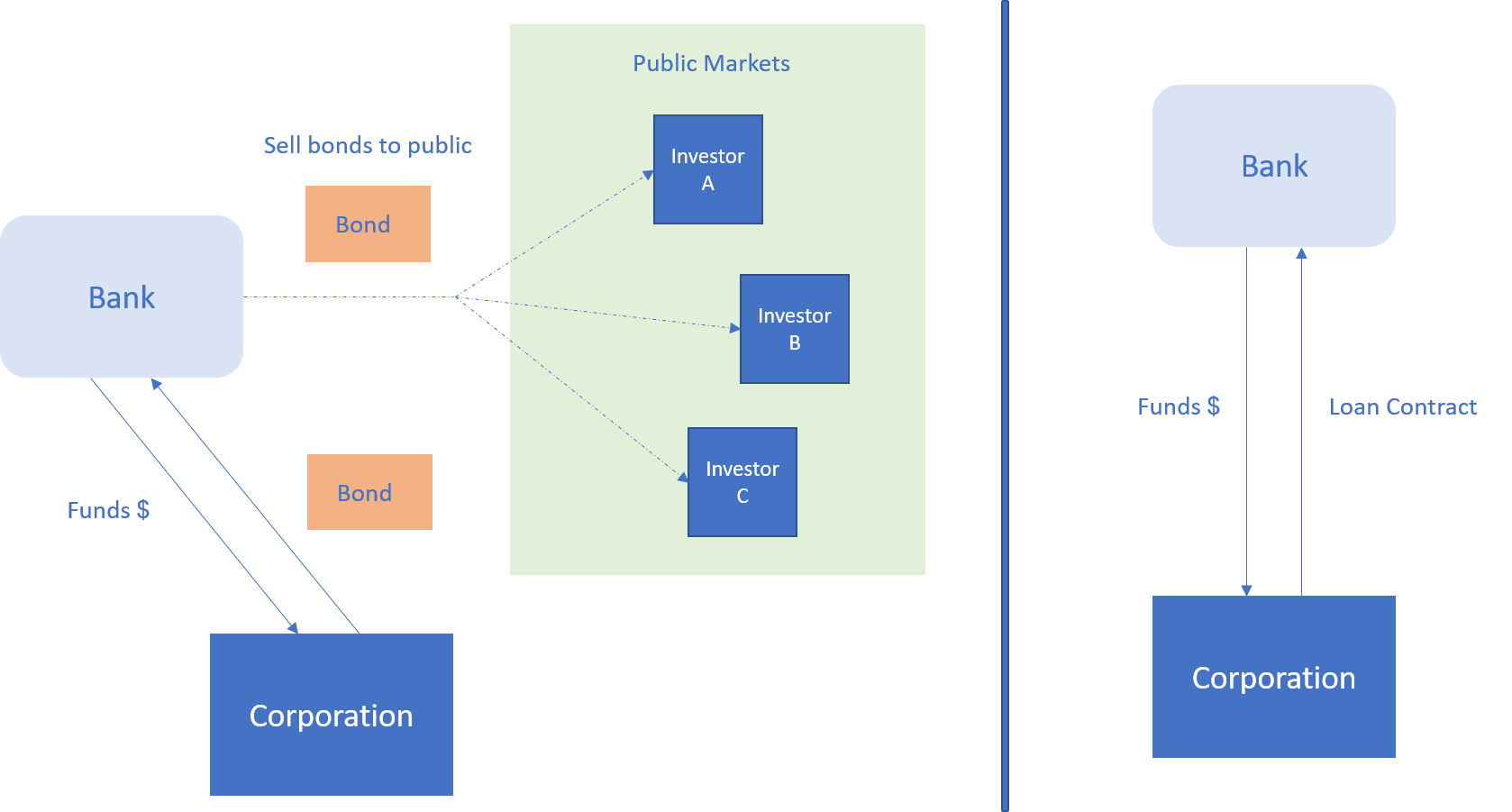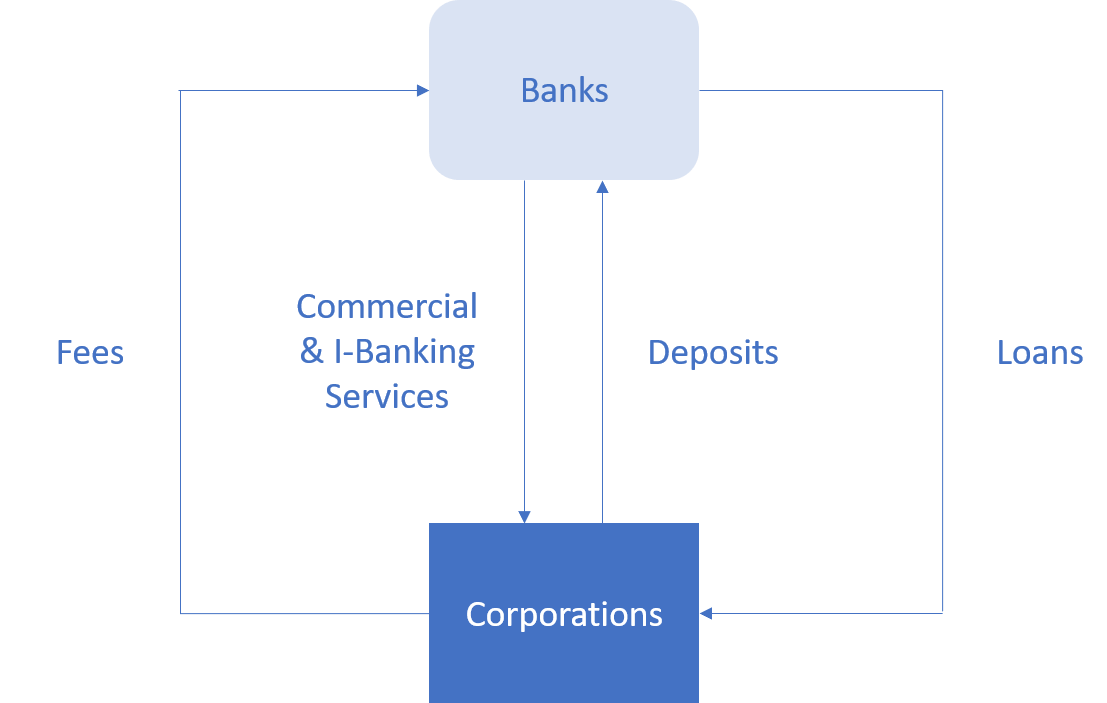The Investor
We shall explore corporations by examining their relationships with other participants in the economy. We will begin by covering how corporations relate to the investor and how both parties cover each other’s needs. If you are not yet familiar with how a company is structured, please take a look at the lesson What is a Company under Investing.
Debt Financing
In order for most companies to grow and expand, it will need to take on debt at some point in its lifetime. Even if a brand new company is fully financed in cash by its founder, sometimes it still makes sense to take on some debt depending on borrowing conditions. Debt comes in two common forms - loans and bonds. A loan is generally a two-party transaction with a lender lending money to a borrower under a contract. Bonds, on the other hand, are issued by the borrower in exchange for funds, but the holder of the bond can sell it in public markets. This way, the holder of the company’s debt can change, whereas with loans, it stays in the static 2-way agreement. When debt changes hands, the company simply stops paying interest to the original holder of the bond and pays it to the new holder. At maturity when the bond expires, the issuing company pays back principal (initial amount borrowed - from borrower’s POV, or lent/invested - from lender’s POV). For the company, this is a way to raise money to expand, hire new workers, or invest in research & development, or R&D. For the investor, this is a way to invest one’s money.

Equity Financing
Another way for companies to raise funds is to issue equity, or ownership in a company. When a company first starts, the founders own 100% of the company. But as it grows and needs to raise money, it is faced with the decision of either raising debt or equity. The cost of debt is the interest that the company would have to pay. The cost of equity is the percentage of future earnings that the company has to give up. If the company decides to raise money by issuing equity, the upside is that it loses no cash compared to interest on debt. The downside is that it loses control over the company and future earnings. For example, let’s imagine that a company with 1000 shares outstanding and 10 owners of 100 shares each decides to raise equity by issuing an additional 200 shares. After the issuance, each of the original owners would only own 1/12 of the company compared to 1/10 of the company before the issuance. For the company, the benefit is obtaining more funds to grow and expand. For the investor, it is a way to get a “piece of the pie” in interesting companies.
The Consumer
Companies interact with consumers in the broader economy instead of strictly through the financial industry. On one hand, it employs workers, paying them wages and salaries in exchange for their labor. On the other hand, it provides useful products and services in exchange for money.

Pay Wages and Salary
A company’s labor force is important to its health and growth. A skilled set of employees will produce better products and services, but will also cost more. The company will have to find a balance between fair compensation and employee productivity. The wages that employees earn then go back into the economy as consumption of goods and services, or as investment - as savings at a bank or as stocks/bonds in public markets.
Earn Sales Revenues
A company’s revenues comes from selling the products and services it provides. These revenues then go towards paying for the expenses of making the product or providing the service, paying employees, paying shareholders. The consumer is the source of these revenues, and this could be individuals, other companies, and even the government.
The Government
Companies interact with the government through paying taxes, using provided infrastructure, and selling its goods and services. In some cases, government can influence the way companies grow and develop, for better or worse. On one hand it regulates companies from an antitrust standpoint by trying to prevent monopolies. On the other hand, it can spur innovation by providing subsidies to certain endeavors like electric cars and renewable energy.

Pays Taxes
Companies are obligated to pay taxes just like mom and pop. This ranges from federal to state and local. However, companies also have many more resources to use to avoid paying tax. This can range from carefully planning a tax efficient financial structure to hiring tax consultants for a myriad of decisions.
Uses Infrastructure
Quality infrastructure benefits everyone from individuals to corporations. It allows us to drive from home to work and back without potholes in the streets and too much traffic (hopefully). It allows companies to transfer and receive raw materials without too many delays (hopefully).
Sells Goods and Services
Companies can sell its goods and services to governments, domestically and internationally. Some examples military contractors, insurance providers, technology systems.
Banks
A company’s relationship to banks is vital to its operations and growth. It needs to access debt capital markets to borrow money, and it needs to access equity capital markets to raise money in exchange for ownership. It uses M&A services to do strategic transactions with other companies and it uses account services to store its funds.

Debt and Equity Capital Markets
Companies get their funds from investors when they issue equity or debt, but most can’t do that directly. Banks are the intermediaries who set up the structure and handle the logistics to connect investors with the securities that companies are offering.
Mergers and Acquisitions
In order to engage in M&A transactions, companies need the help of banks to organize and set up an acquisition. M&A advisors provide guidance and perspective on transactions because they have already seen so many! A small local business might not need the help when merging with another local business, but publicly traded companies often need help with the logistics of the transaction.
Deposits and Payments
Banks offer a variety of accounting services to business. These allow them to store their cash for day to day transactions or invest earnings for a return. Many companies have separate bank accounts for each business area to easily track and manage their money flow.
Corporate Treasury and Pensions
Large companies usually have an entire team or division devoted to handling finances. A treasury department may manage operational money flow for the short term and also invest the company’s cash in securities to earn a return for the long term. Short term investments usually yield low returns at 0.5% to 1% in a few months, but if a company has $10 million in accumulated earnings, that’s $100,000 which is no paltry sum. Pensions invest employees’ retirement savings to grow them so that when their employees retire, they can have a stream of income. Both corporate treasuries and pensions partake as investors in public markets.
Review
Corporations are the drivers of economic growth and at the heart of a capitalist economy. Businesses, large or small, play a large role in our everyday lives as our employers and as providers of products and services. Next lesson, we will examine the role of the investor in our economy.